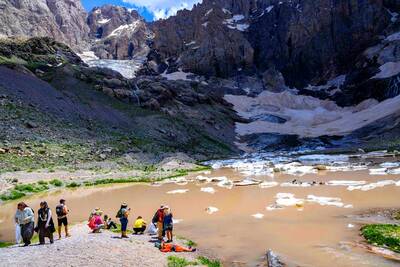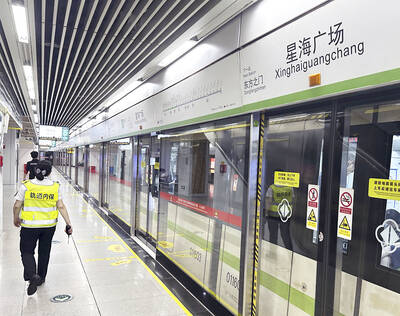Chinese President Xi Jinping (習近平) launched a week-long diplomatic blitz of South America on Thursday by inaugurating a massive deep-water port in Peru, a US$1.3 billion investment by Beijing as it seeks to expand trade and influence on the continent.
With China’s demand for agricultural goods and metals from Latin America growing, Xi will participate in the APEC summit in Lima then head to the Group of 20 summit in Rio de Janeiro next week, where he will also make a state visit to Brazil.
Xi and Peruvian President Dina Boluarte participated on Thursday by video link in the opening of the Chancay port, about 80 km north of Lima on the Pacific Ocean, and signed a deal to widen an existing free trade agreement.

Photo: AFP
Xi said that Chancay, a 15-berth, deep-water port, was the successful start of a “21st century maritime Silk Road” and part of China’s Belt and Road Initiative, its modern revival of the ancient Silk Road trading route.
“China is willing to work with the Peruvian side to take the Chancay project as a starting point to forge a new maritime-land corridor between China and Latin America and connect the Great Inca Trail,” Xi said, referring to a 15th century mountain network that joined the Inca empire.
In an opinion article in the El Peruano state newspaper, Xi said the Chancay project would generate US$4.5 billion in annual revenues, create more than 8,000 direct jobs and reduce the logistics costs of the Peru-China route by 20 percent.
The China-controlled megaport was built by Cosco Shipping Ports and received US$1.3 billion in Chinese investment for its first phase. China is expected to spend billions more as Beijing and Lima work to position it as a major shipping hub between Asia and South America.
The first ship was due to set sail from Chancay next week, transporting Peruvian fruit to China, Mario Ocharan, Peruvian director of the Chancay Chamber of Commerce, said.
China’s main motivation for developing the megaport, according to Ocharan, was access to neighboring Brazil, where a new railway line is planned to carry Brazilian exports such as soybeans and iron ore to the port.
The rail project is estimated to cost US$3.5 billion, according to Mario de las Casas, corporate affairs manager at Cosco Shipping Chancay Peru. Building that link is “crucial” to improve transportation of soybeans as Brazil is the top seller of the commodity to China, he said.
The inauguration of the port comes as Beijing is looking to further tap into resource-rich Latin America, amid trade tensions with Europe and concerns about future U.S. tariffs on Chinese exports from the incoming Trump administration.
China’s major investment in Chancay has raised alarm bells in Washington. General Laura Richardson, former US Southern Command chief, warned earlier this month that Chancay could be used by the Chinese navy and for intelligence-gathering.
US anxieties about Chancay reflect a broader, decades-long shift in a region Washington long saw as its backyard. China has overtaken the United States to become the largest trading partner of countries like Peru.
China’s state-backed Global Times wrote in an editorial on Monday that the port was “by no means a tool for geopolitical competition”, calling US accusations of the port’s potential military use “smears.”

In the sweltering streets of Jakarta, buskers carry towering, hollow puppets and pass around a bucket for donations. Now, they fear becoming outlaws. City authorities said they would crack down on use of the sacred ondel-ondel puppets, which can stand as tall as a truck, and they are drafting legislation to remove what they view as a street nuisance. Performances featuring the puppets — originally used by Jakarta’s Betawi people to ward off evil spirits — would be allowed only at set events. The ban could leave many ondel-ondel buskers in Jakarta jobless. “I am confused and anxious. I fear getting raided or even

Kemal Ozdemir looked up at the bare peaks of Mount Cilo in Turkey’s Kurdish majority southeast. “There were glaciers 10 years ago,” he recalled under a cloudless sky. A mountain guide for 15 years, Ozdemir then turned toward the torrent carrying dozens of blocks of ice below a slope covered with grass and rocks — a sign of glacier loss being exacerbated by global warming. “You can see that there are quite a few pieces of glacier in the water right now ... the reason why the waterfalls flow lushly actually shows us how fast the ice is melting,” he said.

Eleven people, including a former minister, were arrested in Serbia on Friday over a train station disaster in which 16 people died. The concrete canopy of the newly renovated station in the northern city of Novi Sad collapsed on Nov. 1, 2024 in a disaster widely blamed on corruption and poor oversight. It sparked a wave of student-led protests and led to the resignation of then-Serbian prime minister Milos Vucevic and the fall of his government. The public prosecutor’s office in Novi Sad opened an investigation into the accident and deaths. In February, the public prosecutor’s office for organized crime opened another probe into

RISING RACISM: A Japanese group called on China to assure safety in the country, while the Chinese embassy in Tokyo urged action against a ‘surge in xenophobia’ A Japanese woman living in China was attacked and injured by a man in a subway station in Suzhou, China, Japanese media said, hours after two Chinese men were seriously injured in violence in Tokyo. The attacks on Thursday raised concern about xenophobic sentiment in China and Japan that have been blamed for assaults in both countries. It was the third attack involving Japanese living in China since last year. In the two previous cases in China, Chinese authorities have insisted they were isolated incidents. Japanese broadcaster NHK did not identify the woman injured in Suzhou by name, but, citing the Japanese